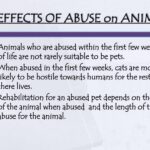What Does “No Animal Cruelty” Really Mean? Breaking Down Misleading Labels
In today’s consumer-driven society, the phrase “no animal cruelty” has emerged as a clarion call for less cruelty and more compassion towards our fellow beings. Yet, amidst the commerce of empathy, there lies a murky ocean of labels that often mislead consumers seeking to uphold ethical standards. Just like a mirage in the desert, the promise of cruelty-free products can shimmer enticingly on the horizon, only to dissipate under scrutiny, revealing layers of complexity. To navigate this deceptive terrain, we must dissect the very essence of what “no animal cruelty” entails and unravel the intricate web of definitions that surround various labels.
At the core of the matter lies a simple truth: “no animal cruelty” signifies a commitment to the humane treatment of animals. It resonates with the fundamental belief that all sentient beings deserve respect and protection from harm. However, the landscape of animal welfare is beset by a cacophony of labels—some illuminating a clear path while others cast shadows of ambiguity. Terms like “cruelty-free,” “humane,” and “not tested on animals” beckon consumers, yet a closer examination often reveals gaping holes in their promises.
Take, for instance, the term “cruelty-free.” While it may evoke images of bunnies frolicking in fields, it lacks a standardized definition across the industry. Many brands don extensive marketing efforts to promote their cruelty-free status, yet their practices may still fall short of genuine animal welfare. Without credible regulatory frameworks or robust certification processes, the label becomes little more than a marketing gimmick—a mere illusion designed to captivate the conscientious consumer.
In stark contrast, “not tested on animals” has become a ubiquitous claim, often misleading consumers about the overall ethical implications of a product’s lifecycle. This phrase only refers to the absence of animal testing for the final product, conveniently ignoring the fact that the ingredients may have been derived from sources that exploited animals. Consequently, the consumer is left adrift in a sea of ethical consumption without a lifebuoy, potentially supporting companies whose practices still contribute to animal suffering.
Moreover, the term “humane” is particularly evocative, suggesting a benevolent concern for animal welfare. However, it often stands on precarious ground. Humane labels can sometimes be applied to products sourced from animals that endure harsh conditions prior to their slaughter. For example, a label might tout “humanely raised” meat, which insinuates a more ethical approach to farming. Yet, the reality often contradicts this proclamation. Animals may still be subjected to confinement and other distressing conditions in their brief lives, which undermines the fundamental tenet of humane treatment.
The irony of these labels is striking. They embody a paradox, where language constructs a narrative of compassion while, on the periphery, the reality crumbles. To understand this phenomenon, one might liken it to a beautifully wrapped present that, when unwrapped, reveals little more than an empty box. The outward appearance charms consumers, drawing them in with promises of decency and integrity, yet the underlying truth remains obscured.
As discerning consumers, we bear the responsibility to wield our buying power intentionally. A deeper understanding of labels can unveil the layers of nuance that exist behind them. Seeking certifications from recognized organizations can provide clarity. Various certification programs strive to hold companies accountable and establish rigorous standards. For instance, being certified by the Leaping Bunny Program or PETA’s Beauty Without Bunnies initiative can offer consumers a credible assurance of genuine commitment to animal welfare.
Additionally, approaching brands with curiosity can lead to insightful revelations. Transparency is a hallmark of ethical business, and companies committed to animal rights should be willing to engage in dialogue about their practices. Asking questions about sourcing, ingredient origins, and overall animal welfare policies is paramount in discerning the veracity of their claims. Every query is an opportunity to challenge misleading narratives and support businesses that uphold ethical standards genuinely.
Beneath these labels lies a realm of ethical conundrums that speaks volumes about our collective responsibility as consumers. We must tread lightly in our choices, promoting not just the absence of cruelty but fostering environments where animals flourish free from exploitation. By eschewing misleading labels, we contribute to a broader movement towards a culture of compassion and empathy, steering our purchases toward those who have forged a real commitment to animal welfare.
Ultimately, the journey towards ethical consumption is fraught with challenges, yet it is a path illuminated by a growing awareness and unity among advocates, consumers, and brands alike. By dissecting the intricacies of animal welfare labels, we can begin to see through the fog of marketing and emerge empowered, armed with knowledge and intent. Recognizing that our choices have far-reaching consequences is the first step towards cultivating a just world—one where the phrase “no animal cruelty” evolves from a hollow promise into a resounding reality, echoing courageously across the realms of commerce and consciousness.







